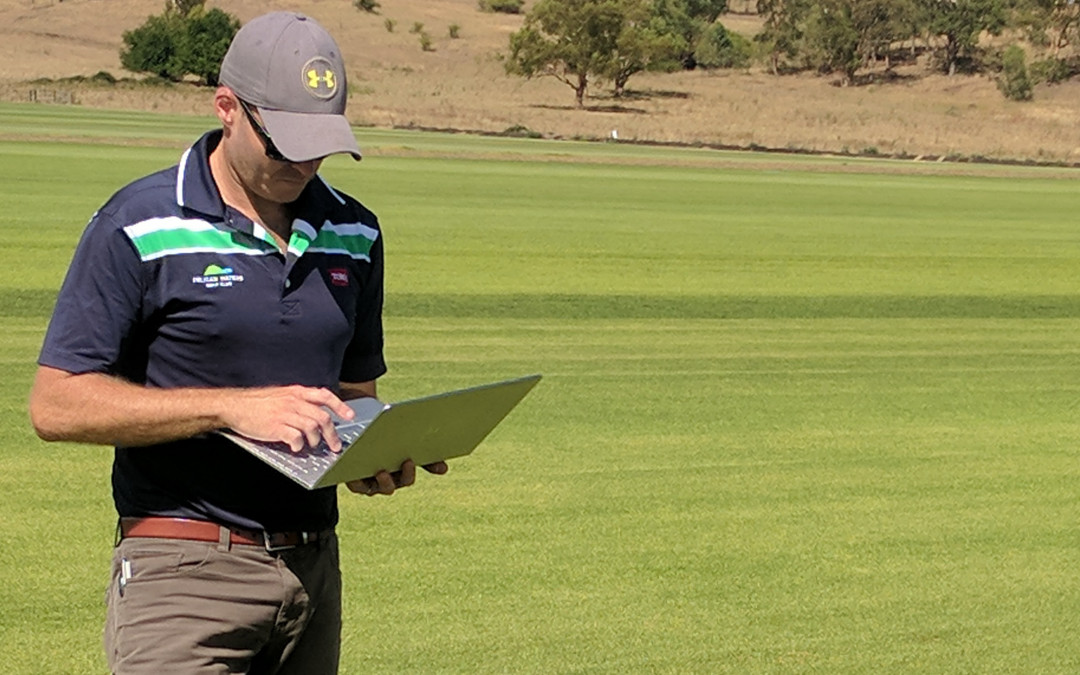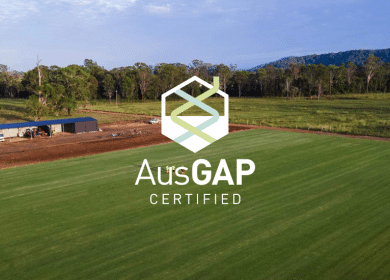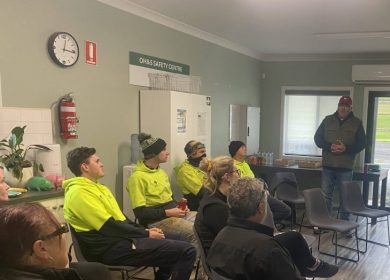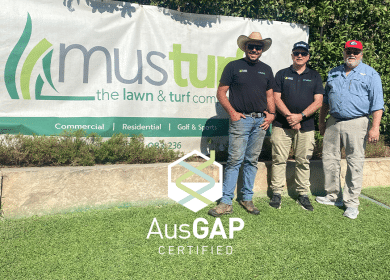

Buying and installing only certified sod ensures that the end user — whether that’s a homeowner, sports turf manager or golf course superintendent — receives the specific variety requested for the specific use needed. It also, however, minimizes customer complaints (and reduces the time, labor and other expenses of fixing problems) and helps protect the business reputation of the landscaper or installer.
Last year, Turf magazine ran a detailed story about the benefits of certified sod, as well as an explanation of the certification process. To read the story only, click here, or read the text-only version below.
Why Certified Matters
Make your turfgrass selections based on quality rather than price.
By Stacie Zinn, March 1, 2014

Bill Carraway, vice president of marketing for The Turfgrass Group (left front of picture), inspects the company’s licensed farms for weeds or off-types. Photos courtesy of The Turfgrass Group.
Outside Landscape Group is a landscape installation company based in Alpharetta, a suburb of Atlanta, Ga., that specializes in residential lawn installations. Kerri Hallahan, operations manager, says that for the past four years, the company has only specified and installed certified turfgrass sod.
“We are holding hands with our clients through the entire process. We get to know them personally. That relationship is important, not only to do the best job for them, but also because they are our main source for future business,” Hallahan says. Keeping the customer happy so they refer more clients to the company is critical to Outside Landscape Group’s success.
“So, if we were to give them a grass that was not certified, and three months down the road, they have problems, that looks bad on us. We want to avoid that situation, if at all possible,” Hallahan says.
The decision to only specify and install certified turf comes from experience. “We have, in the past, used uncertified grass, and, yes, we ran into problems. Nine times out of ten, it’s a zoysia you’re planting and there’s bermuda coming up in it, or there’s a cross-contamination of grasses, or there are weeds. In the past, we had had those experiences, and that’s why now we like to specify certified grass,” Hallahan says.
Fewer complaints
Making this change has created a noticeable reduction in the number of complaint calls the company receives. “We’re no longer having the calls from our clients having issues with their grass. It’s minimized quite a few issues. When you’re putting living plants and grass down, there’s always a possibility, but we have noticed that the issues with the grass have gone down,” she says.
Although the cost of certified sod is slightly higher than uncertified — about 10 percent more for certified bermudagrass, according to Jutt Howard, director of sales at NG Turf, a licensed and certified sod producer with five farms in the Atlanta area — the cost is more than worth the time and aggravation saved. “It is slightly more, but it’s worth it when the clients are happy and there are no issues later on,” Hallahan says. “If there’s an issue, it involves labor or more cost to repair or treat, and the client would ask us to absorb that. It’s to our advantage, and the client’s advantage, to buy a better-quality product and not to have the problems.”
How could the one distinction between specifying and installing certified versus uncertified turf make such a big difference in the daily operations of an installation company? And what is certification, anyway?
Terry Hollifield is the executive director of the Georgia Crop Improvement Association, the certifying agency that inspects sod farms and certifies turf in the state of Georgia, as an agent of the College of Agriculture and Environmental Sciences at the University of Georgia. According to Chet Boruff, CEO of the Association of Official Crop Certifying Agencies, Georgia Crop Improvement is one of 44 such agencies in the United States.
“If a landscaper or an architect knows that he has certain situations that need a certain variety with certain characteristics, like shade tolerance, or winter tolerance in the transition zone so there’s no winter kill, or if he knows he’s looking for a grass that’s low maintenance, the only assurance he has of getting that variety is through certification,” Hollifield says. “State and federal laws don’t apply to vegetative turfgrasses. The only standard is to require certification.”
The certification process
The process of certification begins with the turf developer or breeder. “It doesn’t matter if it’s a university variety or a private variety, you complete an application for approval of a variety to be certified. The application includes information such as breeding history (Was it selected or bred? Produced through asexual reproduction? Naturally occurring? Or irradiated?). Then they complete a section that talks about leaf color, leaf shape, stolon color, length of internodes, all those characteristics that determine a variety,” Hollifield says.
Claims like cold tolerance, shade tolerance or drought resistance must also be substantiated. “If you make a claim, you have to provide me with data. If you make that claim and say it has a light-green stolon, that doesn’t mean anything. It must be in the Munzel color chart or another known color chart. It’s got to be good science. Any claim you make, whether it’s a claim that I use as I make a field inspection, or a performance claim (such as cold tolerance or drought tolerance), you have to provide data. Once you give me your data to support your claims, we have a committee that reviews the claim. The committee is made up of plant breeders and people who know good science. We review it and say whether or not it’s a novel variety,” he says.
Once a variety is approved for inclusion in the Georgia Crop Improvement program, the variety may be licensed to sod producers who plant it on land that is sterilized and known to be free of pests and weeds. As the crop of turf grows in, it is subject to three inspections per year. Specially trained third-party inspectors who are not employed by the sod farms themselves personally walk every inch of a sod farm looking for weeds and off-type grasses. If weeds or off-type grasses are found in a field, that field may be quarantined, meaning no sod may be harvested from that field until the weed or off-type is removed and re-inspected for varietal purity.
Companies like The Turfgrass Group, a firm that licenses certified, proprietary turfgrasses to sod farms in the U.S., takes certification a step further, requiring as many as three additional inspections by a member of their team. “Sometimes I feel like I’ve walked from Georgia to Alaska and back five times in my career looking for that needle in a haystack,” says Bill Carraway, vice president of marketing for Georgia-based The Turfgrass Group. Carraway, who has worked both as a landscaper and a sod producer, inspects every one of The Turfgrass Group’s licensed farms for weeds and off-types. “With some varieties, you’re looking for a needle in a haystack, that clump of grass that may be no bigger than a thimble. Sometimes you find a patch of off-types as big as a trailer-tractor rig.”
If anything but the certified variety is found in the field, no sod may be harvested until the field is cleared of the infestation, re-inspected and recertified. “We require state turfgrass certification on every variety that we release or take into the marketplace. It’s one of our fundamental imperatives. Genetic purity is part of our mission statement,” Carraway says. Those varieties include: Zeon Zoysia, JaMur Zoysia, TifBlair Centipede, L1F Zoysia, T10 Bermudagrass and TifGrand Bermudagrass.
“Certified sod from a licensed and certified sod producer establishes the integrity and genetic purity of the product. You know you are receiving the product you are paying for and that it comes with a State Crop Improvement Association Certificate establishing the provenance of the grass,” Carraway says.
“I use an analogy. I used to ask the question, ‘Why buy certified turf? Why pay more for the same Tifway 419? The guy that’s certified just costs me more.’ My analogy was this: I like to hunt. I like Labrador retrievers. If I wanted to buy a new lab, I’d only buy a registered lab so I know I’d be buying a genetically purebred lab. Why? So I’m guaranteed that I know the genetics, I know there’s no other DNA but lab in that dog. I know there have never been any foxes in the hen house. All of these same principles apply when purchasing certified turfgrass. I know the pedigree. I know it comes from a reliable source. You’re protecting your clients, and you’re protecting yourself,” Carraway says. Hollifield agrees.
Be aware of imposters
“I’ll give you an example that validates that statement. If you go back to the 1980s, there were as many as 10 or 12 different kinds of Tifway being sold, 10 or 12 imposters being sold as Tifway. In about 1990 or 1991, I performed a survey in Georgia and collected samples from big-box stores and nurseries. About 50 percent were in fact not Tifway. The only way to make sure you purchase Tifway, or any other specific grass, is to buy certified,” Hollifield says.
“We are trying to assure the end consumer that he is receiving the specific variety that he has requested that fits the application that he is looking for. If he has an athletic field and he wants Tifway, we want him to know he’s using Tifway. If we are planting a golf course with a lot of shade, and he wants TifGrand, we want him to know that he’s getting TifGrand.”
NG Turf grows 10 varieties of turfgrass on some 2,000 acres spread over five farms in north Georgia. All of the varieties are grown as certified turf, with the exception of just a few acres of Tifway 419 and Meyer zoysia, although both are also available as certified as well.
NG Turf started in 1985 with just 10 acres of certified Tif-2 bermudagrass. Howard says growing certified turf is what has “been able to keep us as a leader in the marketplace. It sets us apart from other sod producers.”
And he believes that growing certified turf is the future of the sod industry. “It’s becoming more and more demanded. If you’re not growing certified varieties of grass, I don’t think you can stay in business,” Howard says. “All of the new grasses that are developed by breeders, certification is not a choice. It’s required to get the license. If you are a turf producer and you’re not getting into these niche grasses and new varieties, if you’re not growing certified grass, you’re not going to stay in the industry really long.”


